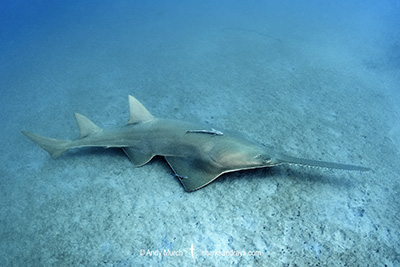Common names
Green Sawfish.
Binomial
Pristis zijsron.
Synonyms
zisron, Pristis zyrson, Pristis zysron, Pristis zysross.
Identification
An extremely large, heavy-bodied sawfish, covered with rough denticles. Rostrum long and wide, with 23-37 paired rostral teeth. Teeth closer together at rostral tip than base. Rostrum length 0.23-0.33 x total length. First dorsal fin origin significantly posterior to pelvic fin origins. Dorsal posterior margins straight or weakly concave. Pectoral fins narrow and long, anterior margins weakly convex, posterior margins straight, apices obtusely angular. Caudal fin posterior margin weakly convex in jveniles, straight in adults, without a defined lower caudal lobe. No secondary lateral keel below main caudal keel at caudal base.
Colour
Dorsum greenish-brown or olive. Ventrum White, Rostral teeth white.
Size
Maximum length 730cm. Size at birth ~80cm.

Conservation Status
CRITICALLY ENDANGERED
The Green Sawfish (Pristis zijsron) is a bycatch component of a variety of demersal fisheries, notably due to it’s tooth lined rostrum which is easily entangled in nets and line. Historically, it was heavily targeted for the high quality of its fins.
Even though international trade of all sawfish species is now prohibited since their inclusion in CITES Appendix 1, an illegal trade in sawfish rostra still exists and in some areas they are also still targeted for their meat and fins. Habitat loss and degradation are also significant factors in the green sawfishes continuing decline.

Habitat
Tropical/ warm temperate inshore habitats. The green sawfish is generally associated with mangrove and other shallow coastal and estuarine environments, but it does occur further offshore at depths exceeding 70m.
Distribution
Historically widespread in the Indian Ocean and southwestern Pacific but now rarely encountered. Possibly extinct from much of its former range Remnant populations exist in the Gulf of Arabia, Red Sea, and throughout southeast Asia and northern Australia.
Reproduction
Aplacental lecithotrophic viviparous. Litter size ~12.
Diet
Probably feeds mostly on crustaceans and other benthic invertebrates.
Behavior
The green sawfish has a mostly sedentary lifestyle. Tagged animals in the Gulf of Carpenteria in Northern Australia remained in shallow water and transited less than 200m in a 24hr period.
Reaction to divers
Unknown but likely difficult to approach.
Diving logistics
Green sawfish encounters by snorkelers and divers in the wild are virtually unheard of. Northern Australia is probably the easiest place to look for this species but visibility is generally very poor and the entire region has an abundance of large, potentially dangerous saltwater crocodiles.
What’s new
View our full list of updates
Similar species
Smalltooth Sawfish Distinguishable by dorsal fin origin that is closer to pelvic fin origin.



